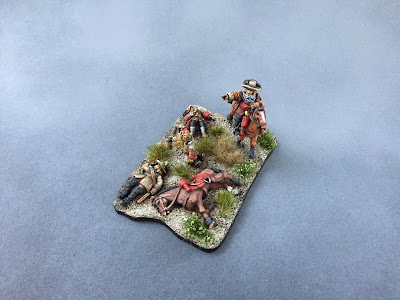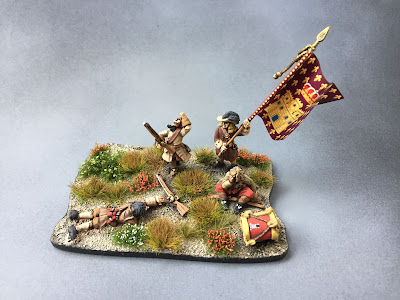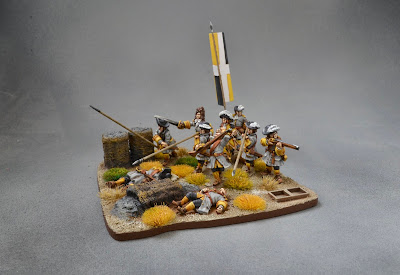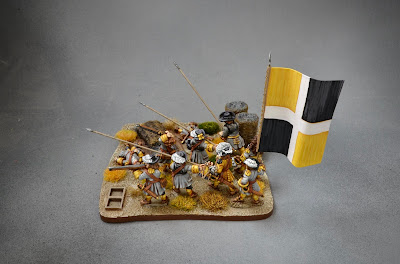"Sound trumpets! Let our Bloody colours wave!
And either victory, or else a grave!"
Henry VI, Part 3 (Act 2, scene 2)
Just about the final submission I painted for the eleventh Analogue Hobbies Painting Challenge was a large single base featuring casualties and a dramatic last stand of the French Regiment de Louvigny from 1688.
I'd had this collection of figures on a single base in mind for a while. You might remember that a few years back I did some 'flight' bases. These were single stands of units in various stages of complete rout or terminal breakdown. They were quite addictive to covert and paint. Here's a section...
The idea behind these bases was to clearly reflect, on the wargames tabletop, the changed condition of battlefield units. Instead of viable formations, a player would be faced with terminally damaged units. Or, as Sir James Turner, a veteran of the Thirty Years War would put it - "shipwracked" battalions.
In the Thirty Years War rules I used for 2mm games a few years back, withdrawing terminally damaged units from the Field was important, as victory points were available to an opponent who could shatter such tempting targets.
But with the last stand of Regiment de Louvigny, I wanted to take a different snapshot in time. Here, I was trying to capture a stage between a viable regiment, and a shattered collection of soldiers. I wanted to recreate the state of order being lost, but where the battalion is still fighting - a last stand, in essence.
I felt I only needed a single base. The order would be lost, with the drill-book delineation of pike and shot broken down. Men would be dead and wounded, but the colours would still be flaunting the sky. Officers would still be leading. Drums would still be heard above the chaos of battle. The battalion would still have claws and teeth, although no one would know for how much longer.
What I had in mind was a single centrepiece for a large skirmish in which the "shipwrack" of a French battalion could (possibly) be rescued from Flemish, Imperial or Spanish enemy forces by a relieving friendly French brigade. It would suit an evening's narrative wargaming, or perhaps be a smaller table in a day's gaming.
The small "slots" for two micro-dice are there to record casualties and cohesion. As the regiment in its battered state is not really functioning as a working formation, there's no need to identify the pike and shot separately in any normal basing formation. All that is now important is the remaining cohesion of the battalion as an entity - hence the dice marking that. As the casualties, shock and chaos mount, so the dice can tick up, or down, depending on how you like to show such things.
So, rather than just a 'casualty base', I could use the Last Stand as a half-way house between functioning battalion and a mere marker for routed troops. For that reason, it's about twice as large as the 'flight' bases in the photos at the start of this Blog post.
After deciding on the type of base I wanted, it was really just a case of deciding which figures I wanted. I chose a blend of of pike and shot, officers and soldiers, a drummer, and a blend of dead, wounded and still-healthy troops.
In retrospect, I should have done better in painting the standard, which looks a little too pristine for any 'last stand'. And maybe the casualties could have been a bit more numerous. But I didn't have long to prepare the stand at the end of Challenge XI and I'm hopeful it can pass muster on most tabletops.
The perfect is, of course dear friends, the enemy of the tabletop-standard.
The Regiment de Louvingy is for my late seventeenth century 1688 Flanders collection, so I tried to make the figures fit with the other units and formations by adding green-stuff feathers, lace, ribbons and swapping the Officer's right arm from carrying a standard to more nobly raising his sword towards the Flemish and Spanish Enemies-of-his-Blood.
I took the uniform of the Regiment de Louvigny from Mark Allen's fine book "Armies & Enemies of Louis XIV: Volume 1 - Western Europe 1688-1714" (published by Helion). The real Regiment de Louvigny is a rather forgotten, anonymous regiment - so I felt it was time to bring its soldiers back to the grand stage of European warfare on the wargames table.
The figures are a mix of Dixon Miniatures and Wargames Foundry, with a Colonel Bill's casualty figure added at the front. The splendid, and very versatile, gabions are from Frontline Wargaming. The base is a terrain base from Warbases, who also made the micro-dice slots. The tufts are from WSS Scenics.
No one makes the standard for the Regiment de Louvigny - so I painted it myself. And yes, from the angle below, it really still does look too pristine !
And because this is a submission featuring the ludicrousness of my fictional campaign for the Flemish Free-City of Laarden, in 1688, here's the Challenge XI Collectible Card for the "Last Stand of the Regiment de Louvigny" - another in my 2021 collection of the "Enemies and Adversaries of Laarden, 1688".
I hope you enjoyed this post from Challenge XI. There's more to come in this vein, but next time up, I'll have my crystal ball and scoresheet out, as we take a look at the "Portents of Laarden".
Hope you can join me for that, dear readers!
*******
























Beautifully posed and painted and a great idea too:)
ReplyDeleteThanks very much, Steve!
DeleteBrilliant idea splendidly executed Sir!
ReplyDeleteThanks very much, Phil !
DeleteExcellent !!
ReplyDeleteA great collection of vignettes
ReplyDeleteThanks very much...took a while to find some of the old photos!
DeleteOutstanding job, so many gems in a single post!
ReplyDeleteThanks very much, Phil !
DeleteA lovely base, and an interesting counterpoint to the ‘flight’ bases. Good to be reminded of them. Inspirational as always - It’s given me some ideas for an artillery base.
ReplyDeleteThanks Andy - really pleased you liked it. It's a flexible idea - and would be perfect for an artillery base, for sure.
DeleteAn interesting idea beautifully applied. I particularly likes how you have them taking their stand and fighting from the corner of the base - works very nicely. Your collection is developing beautifully and I admire your collection of similar vignettes - all very unique and interestingly thought through. Thanks for posting.
ReplyDeleteThank you very much indeed! The placing of the figures in the corner of the base allowed me to use the levelled pikes - which can be tricky to use on most bases. I thought about trying to fix the figures into more of a 'hedgehog', but when I tried that the base size didn't work as well. Thanks again and thanks for the kind words.
DeleteVery evocative
ReplyDeleteThanks very much, James!
DeleteSome fantastic additions to your collection! My fav are the Louvigny regt. A French unit with yellow cuffs! Well I never!
ReplyDeleteI love those vignettes, I did a similar 3 or 4 months ago, yours are really an inspiration!
ReplyDeleteBy the way, I have a question for you... If you were doing a saker with civilian crew in the same period, which miniatures would you use? I am doing a barricade with a gun, and some civilians mixed with soldiers defending it under pressure, with gabions and all that stuff.
thanks and cheers!
Lovely work!
ReplyDeleteWhat a lovely selection of stands/vignettes/dioramas Sidney.
ReplyDeleteWhat ever you use them for they will certainly add interest and colour to your table.
All the best. Aly
Amazing work Adam!
ReplyDelete